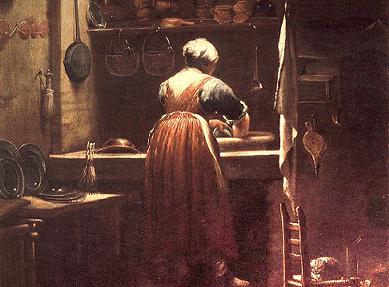 |
At the back of the kitchen area there is a small room called a scullery. It is here where you will find a large metal sink used for washing pots and pans as well as washing and preparing "messy" foods such as fish. You'll also find a wooden washtub for washing the china, glasses and silverware; a metal washtub, washboard, iron and ironing board for doing the laundry and a small cabinet where other household cleaning supplies are stored.
By the mid-1800s most middle-class homes had running water. The water comes into the scullery where the primary use is for kitchen work and the laundry. By the 1870s, pipes were being installed to bring water to the upper floors to furnish water for the water closet. Water usage1 is estimated at 22 gallons per day per person.
| Domestic use, excluding laundry | 9 gallons |
| Water Closet | 5 gallons |
| Baths, once a week | 5 gallons |
| Washing clothes | 3 gallons |
The cost is approximately 3s per week for an intermittent supply. The water companies typically provide water 3 to 5 days a week (never on Sunday) for an hour or two per day. The larger middle class homes are able to accommodate for this so that water is available when needed. It won't be until the 1890s when water supplied without interruption will start becoming available, but it will take some time before accessible to all homes.
While Ashton's do not employ a "dedicated servant" to the scullery, it is typically the Scullery Maid, considered the "lowest" of all servants, who is assigned to do these chores. She is sometimes found in a workhouse. The wages for a Scullery Maid is approximately £2 to £5 annually.
|
Back to Intro/Index or Site Map
|
Credits:
Site, background, and buttons are the creation of the webmaster, B. Malheiro. The scullery picture features an oil done on canvas back in the early 1700s by Guiseppe Maria Crespi titled "The Scullery Maid".